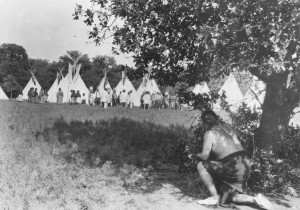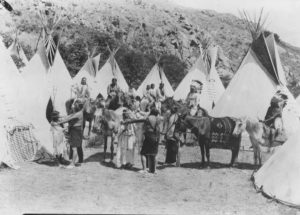
The cast of The Daughter of Dawn consisted entirely of American Indians: more than 300 Comanche and Kiowa. Wearing their own clothing, the actors also brought their own personal belongings, including teepees.
One of many docudramas that romanticized Native American culture, The Daughter of Dawn was one of several films boasting all-Native American casts, including In the Land of the Head Hunters (1914), Hiawatha (1913), The Vanishing Race (1917), and Before the White Man Came (1920).
In 2013, the Library of Congress selected The Daughter of Dawn for preservation in the U.S. National Film Registry.
As a document of such an important period in Oklahoma history, the film was acquired by the Oklahoma Historical Society in 2005.
The cost was only $5,000. Or $30,000 less than the initial asking price by a North Carolina private eye who had accepted the film as payment from a client about 10 years ago.
The restoration cost $20,000, said Jeff Moore, director of Oklahoma Museum of Popular Culture, a project overseen by the Oklahoma Historical Society.
Moore also said it was great to be able to share the film with some of the actors’ descendents at a screening at Cameron University in 2012 in Lawton, near where a large part of remaining Comanche live. More than 350 filmgoers flowed out of the theater.
Although UTA’s Vielle is Pikuni from the Blackfeet Indian Reservation in Montana, she said she considers the Native American actors in The Daughter of Dawn her ancestors.
“Because in the whole aspect of it, they are,” she said.
Vielle said American Indians “weren’t really seen as real people back then” and that Hollywood Westerns often focused on the mistreatment of American Indians. The Daughter of Dawn, she countered, portrays the true West with scenes of buffalo hunts and ceremonial dances.
“There’s love,” she said. “There’s engagement. There’s family life. There’s rivalry. There’s connectivity. There’s everything that everyone else experiences.”

One of the places where The Daughter of Dawn has screened is Austin. The audience reaction there was “very positive,” said Chale Nafus, the Austin Film Society’s recently retired director of programming. “Also, since many Hollywood films depicted American Indians in a negative light, this is a refreshingly different portrayal.”
Texas Archive of the Moving Image, a nonprofit whose members locate and preserve Texas films and create awareness of our cinematic heritage, helped bring the film to Austin. About 200 people attended the screening, said Madeline Moya, archive managing director.
“People were really impressed with the production,” she said, referring to the Texas Film Company, the independent Austin agency founded in 1916 that was behind The Daughter of Dawn. “It’s one of the early production companies in Texas. It has historical significance.”
The Daughter of Dawn originally screened in Los Angeles, Kansas City, Tulsa, and a handful of other U.S. cities. Post restoration, the film premiered (or “re-premiered”) in June 2012 at the deadCENTER Film Festival in Oklahoma City. The rerelease was accompanied by an original music score composed by Comanche Nation member David Yeagley.
Ron and his brother, Don, recently traveled to Rhode Island College for a panel discussion about the film. Ron watched the movie there for the first time. He said that although there was nothing new in the film that he has not seen in his lifetime, he still felt mixed emotions.
“I was happy that people can see real Native Americans in the movie,” he said, “but sad because that way of life is no longer here.”
Ron said he was glad to see Oscar Yellow Wolf in the film as well as teepee encampments and elderly women wearing traditional style of dress.
“Oscar Yellow Wolf often rode his horse to visit my great-grandmother,” Ron wrote in an e-mail. “I remember my grandmothers wearing pitskwinas, but [the aprons] are seldom seen today. Comanches are noted for use of horses, so it was good to see their horsemanship and chasing of buffalo.”
Moore, who has watched The Daughter of Dawn about 20 times, talked about the film’s authenticity, including its unique setting in the Wichita Mountains, the clothing, and the horses.
“A lot of the really skilled horsemanship is done by the older men,” he said. “They are in their 60s or 70s. It’s not the younger men. It’s the older ones.”
Moore said some of the men would have been pre-reservation plains warriors.
“The filmmakers weren’t lazy,” he said. “Each shot is unique.”
Myles gave credit on his script to Texas filmmaker R.E. Banks, whose “knowledge of the Indian, and of his traditions, was gained during the 25 years that he lived with them.”
Myles is known for his work as a makeup artist on The Wizard of Oz, and he spent three years on the Shakespearean circuit and also filled vaudeville roles. Myles eventually earned leading man status as an actor and worked for various studios. In 1916, he began writing and directing, but a battle of wills with Hollywood brass left him blackballed and searching for a gig elsewhere.
Banks, who had started the Texas Film Company, was glad to accommodate him. He and Myles teamed up for The Daughter of Dawn.
Leo Kelley, an Oklahoma history teacher, said Myles once wrote about how some people had joked that he may need to watch his scalp, but “they would be surprised to know … that the [Indians] spoke better English than [we] did.”
Moore said the film is unique because most Westerns during that time period would have an American Indian as the bad guy and a Lone Ranger-type as the hero, but in The Daughter of Dawn, both the protagonist and the antagonist are American Indians.
“What makes this film unique is that the director used real people in a non-documentary film,” the Austin Film Society’s Nafus said. “They wore their own clothing, used their own props, and moved about in their natural setting. So the film becomes a kind of docudrama combining two genres.”
Moore said the film appears to have been well received, but because it was made by an independent company, it lacked national distribution, limiting its popularity. Then a fire at the Texas Film Company was believed to have destroyed all known copies of the film. Nitrate films are combustible, and due to the heat and humidity, such fires were common.
“Some of the films would just go into flames on their own,” he said. “Less than 5 percent of independent films [from that time period] still exist.”
Moore explained how film scenes were sometimes tinted to make daytime scenes look as if they were shot at night, a process that may have saved The Daughter of Dawn.
“It’s a master copy,” he said, “possibly one of the films that was sent out to be tinted.”
Moore said collecting, preserving, and sharing Oklahoma history is the mission of the society and being able to share The Daughter of Dawn with the world does just that.
The movie “portrays a period of time that is so important to the American West,” he said. “It’s very special.”
******












Excellent article placing the film in an historical context. I learned a lot from the information and ties to Fort Worth. The film is unique and we had a really successful presentation earlier this year as a co-sponsorship of Austin Film Society, Texas Archive of the Moving Image, and Humanities Texas. It’s great that people in the DFW area will be able to see DAUGHTER OF DAWN early next year at UT-Arlington (my undergraduate alma mater).
White man come. Take land. Kill buffalo.
And so it goes, nothing new to see then…same’ol, same’ol today. You know very many hammer-headed, Repug Tea-Baggers? When Lyndon Johnson, as America’s President, caused our country to begin acting like we believed Black people were entitled to common decency, fairness, & respect, well…the snot-rag, bastard, bigots bailed out on the Democratic Party almost in their entirety…. thank you Jesus. Texas and the South mostly votes hammer-headed, black-hearted, hooray for me,,,screw you Repug Party from then until today. Texas had been a consistent Democratic state up until that time, but no more. You will not read about this in the school books, however it’s the truth, on the record. Texas also writes the school books for our nation…true, see? Check these facts out first, then tell the butt-wipe Repugs to kiss your hiney. May God bless America and all our ships at sea.
Hello, I am a desecndent of Esther LeBarre. She is my great, great aunt.You ran her picture in the paper last week in a write up about Daughter of the Dawn. She was the female star of the film. Although I understand that Quanah Parker and his children are a bit more famous, I was quite surprised that her name was not mentioned once in the article. My family still holds to our traditions as well. I am the youngest in a line of Kiowa Comanche bead workers. I’d appreciate if you drop a note back to me. Thanks! -Autumn Marie Moss